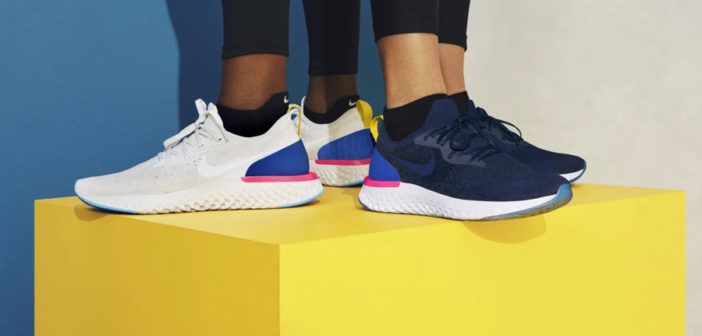Nike’s New React Running Shoe Is Flubber For Your Feet
Rob is a perfectly proportioned, living, breathing Coors Light commercial of a man. He talks about running a marathon without really training for it and, recently, his “first” 50K. Of course he would be who Nike would send to take me–someone who hasn’t exercised in six months, maybe a year–for a tour of their latest shoe, not some normal human being, but 180 impossible pounds of Just Do It.
“Let’s run a couple of miles,” he says with the casual rapport of a lesser-known Marvel superhero.
We’re at a gym in Chicago’s north side, stepping onto side-by-side treadmills to try out Nike’s latest paradigm in shoes: Nike Epic React Flyknit. I haven’t run regularly in nearly a decade. I am terrified. But dang, my feet sure do look good.
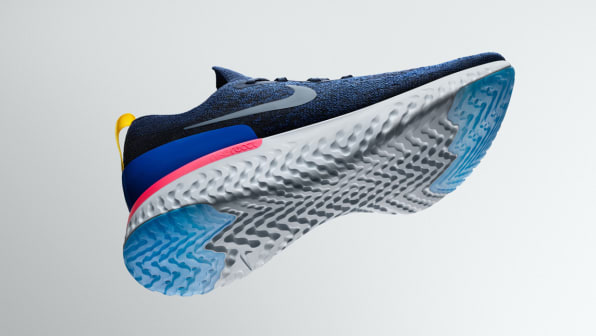
Three years in the making, React is Nike’s sequel to its pillowy Lunar technology, and the Epic React Flyknit is the first running shoe to feature the new technology. With it, Nike is chasing one of the biggest performance-fashion trends led by Adidas’s Boost line. Like Boost, React is a shoe all about maximalism, rather than the barefoot minimalism of the past few years. Its main feature is a giant sole made from a single block of foam, which promises to put a percentage of the energy from each footfall back into your next step.
The goal of React is to be the trifecta of what most people want in a running shoe: light to lift and soft on the footfall, but with the ability to bounce back with your stride, rather than bottoming out. In the industry, they call this third trait “energy return,” and it’s the hottest promise in athletic shoe technology today. The barefoot running era of the early to mid-aughts is over. Now, it’s all about big soles and energy return.Of course, a large sole is a necessity for foam to achieve this rebound, but it’s also an advertisement of soft springiness–just looking at the Epic React, you feel like it must give you some extra power as a runner. “We wanted it to be visually distinct, and to be intuitive when you pick up the product,” says Brett Holts, VP of Nike Running Footwear. “You see there’s something about this that looks softer, more cushioned than a slab of foam. There’s a visually intuitive part to [to this approach].” Meanwhile, the upper is a tighter weave of Nike’s Flyknit technology than its sometimes sock-like weaves, which secures your foot tightly onto the pad.
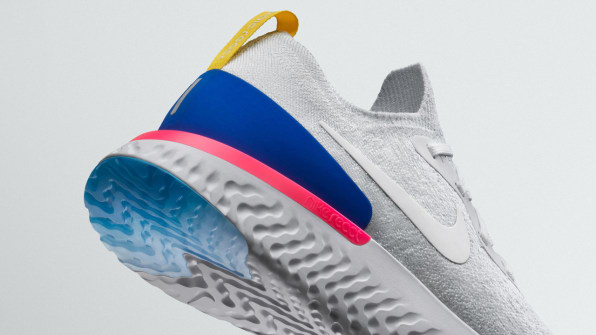
Unlike most athletic shoes, there is no hard outer sole “cage” or internal air bags for the soft foam of the Epic React. Instead, the proprietary React foam–which itself is mostly made of synthetic rubber, normal for car tires but a shoe industry first–is punctuated by a bit of harder rubber under your toe and heel, to maximize durability on pavement. React was the product of Nike’s own innovation lab, and the result of over 400 attempts of mixing new materials at a factory in Taiwan, shaping them and cooking them in ovens, then testing these bricks of foam before actually molding them into a shoe and trying them on. Testing includes the simple thumb test (pressing in your thumb, seeing how far it sinks in, and then how it bounces back), but also includes hooking the material up to small machines that can measure these traits in quantifiable numbers. Again, Nike was looking to make something that could bounce like a rubber ball, but strike like a feather, a combination that, if you think about it, doesn’t really exist in the material world.
“It’s a lot like baking. You have your bread, flour, egg, and salt. And yeast,” says Hossein Baghdadi, director of Nike NXT Footwear, and lead on React. “I can use different yeast strains, different flours. Different salt. But also combine them in different ratios. And depending on how I bake that bread, I can end up with a nice crust, or I can burn it, or I can overcook it.”
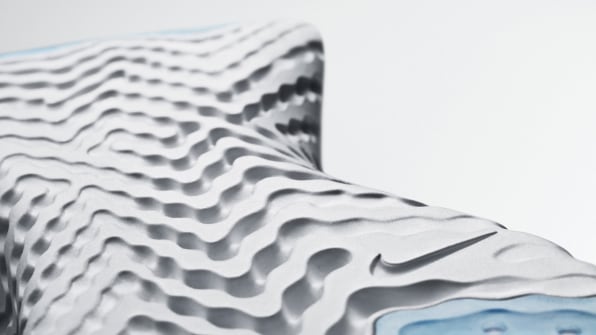
Baghdadi’s team tested new mixes and baking methods on a daily basis. They could literally come up with a new composition and be holding a foam block a few hours later. In a few more hours, that foam could be a prototype shoe on their feet. Each chemical iteration was tested with all sorts of machines and methods, but ultimately Baghdadi became extremely good at just feeling such minutia on his feet.“There was one moment when I tried on a pair of shoes, and was like, ‘holy bleep.’ This was different, this was good,” recounts Baghdadi. “Then it was a question, do other people feel that?” Samples were sent to Nike’s headquarters in Oregon, and Baghdadi confirmed that other people felt the same way, too. The React was light, soft, and springy. Everyone from Nike’s own employees to its partner athletes loved it.

But Baghdadi is quick to point out that chemical engineering was only half of React’s design process. The geometry of the foam needed to be carefully designed, too, and tweaked to maximize the mechanical responsiveness of the material depending on each shoe size. For this step, Nike, in another first for the company, turned to computational design, using software to shape each shoe size’s unique sole for maximum energy return.“The pattern is a direct output of that algorithm,” says Holts. “If you were to compare, take the React foam itself versus the React foam with the computational pattern, it’s actually much softer with the computational pattern upon impact, but it’s also more resilient upon impact, meaning it gives more response at the same time.”
Computational design also allowed quicker iteration. In the case of the Epic React this was key, as Nike decided that each half shoe size in the line required a unique sole shape to maximize its own promised energy returns. Such a size-by-size approach to building soles isn’t unheard of, but it’s far more common for a single core sole shape to be designed and simply scaled to all of the shoes in a model’s line, with testing only in the middle and at each of the extremes.

“What used to take weeks to months was taking honestly hours to days when we went computational,” Holts continues. “Then there was another benefit: We could take pressure data from athletes, and the hundreds of runners through Nike Labs, to be an input to those algorithms to give you more information, tweaking the algorithms to give more cushioning where athletes want it, or carve out weight or volume where you don’t need it.”All of those decisions produced the Epic React, tested over 17,000 miles of running, and available in two colorways to the public on February 22, for $150 (though, no doubt, the core React technology will make it to more shoes soon). While you can call it a response to Adidas’s successful Boost line, which has helped Adidas regain its spot just behind Nike as the second biggest athletic shoe manufacturer in the world, it would be unfair to call it a copy. Adidas’s Boost line features brashly unfinished, Styrofoam-looking soles. Even if they can help you dunk a basketball, they’re too cool to admit it. Meanwhile, Nike’s Epic React is carefully finished with speed lines that, like a sports car’s, make them look fast just parked by your front door.
So how did the Epic React work out for me, a guy whose body is in peak physical condition to rock his newborn at 3 a.m. or open the occasional wine bottle on the weekends? As if sensing my own trepidation at the offer of a “short, 5-6 mile run” with a Nike expert, Nike not only sent the Epic React shoes for me to try, but accompanied them with a small wardrobe’s worth of performance Nike gear, ranging from a sweat-sopping jacket to an $50 pair of knee-high compression socks.
So I cover myself head to toe in the bright polyester blends that are vaguely reminiscent of European clubwear circa 1998, gaining confidence the way many reluctant athletes do: by wrapping every inch of my skin in aspirational branding.
I am the swoosh incarnate.
My first run with the Epic React is like jogging on marshmallow fluff. It’s almost eerie how smoothly proportioned the foam feels, from heel to toe, even as I purposefully shift my stride from running on the balls of my feet back to my heels in an attempt to find weak spots. A relaxed mile and a half later, Rob assures me that he is sweating, too–really!–even though only one of us is breathing through his mouth. We adjourn. With suddenly cramped legs, I opt to sit in a chair, rather than work at my standing desk, to write this article. I assume Rob is sending emails while squirrel suiting to his next ultramarathon.
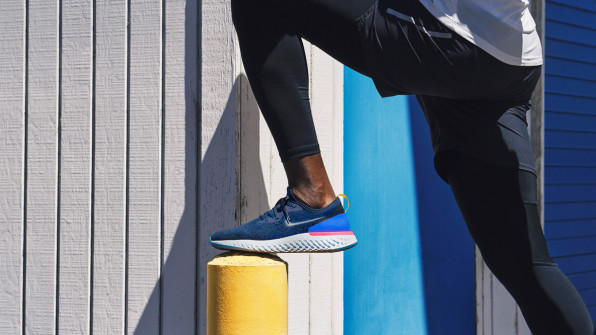
But it’s only now, slipping back on my aging pair of black Nike Frees, that I realize just how good the React technology feels. My more minimalist Frees–the go-to fashion statement in Brooklyn before Adidas’s Boost usurped that role–feel like a fuck you from gravity with every step. As far as I’m concerned, walking a single step without all that algorithmic, synthetic rubber assistance has become a sucker’s game. Long live giant foam.Of course, fashion and performance claims aside, footwear preferences are extremely personal. It’s why Nike’s strategy going forward is to support maximalism and minimalism across its wide line of shoe technologies. It can be everything to everyone. That said, Nike has clearly ditched the “nature amplified” tagline Mark Parker repeated again and again when I visited the campus in 2013, as the company attempted to take over the barefoot market and sell us shoes that felt like wearing socks.
By redoubling its efforts into thick foams, Nike is confirming that the minimalist era is over. We’re in an arm’s race of energy return technology. And as a consumer, it only takes a half an hour in Nike’s or Adidas’s extra-cushioned shoes to remind you that walking on clouds really is more comfortable than running on concrete.
“For the majority of runners, or people, the number one filter is comfort. And that’s why you see the industry go through these swings. There was the whole minimalism thing–and that was a trend we were part of that because there was a potential benefit there–but it swings back to what’s really comfortable,” says Holts. “There will always be a preference, whether what’s trending minimal or maximal. And we’ll always have a cushioned, soft yet responsive solution, because we think that’s where the majority of [people]tend to gravitate.”
–
This article first appeared in www.socialmediaexaminer.com
Seeking to build and grow your brand using the force of consumer insight, strategic foresight, creative disruption and technology prowess? Talk to us at +9714 3867728 or mail: info@groupisd.com or visit www.groupisd.com

